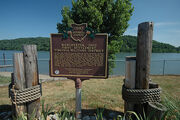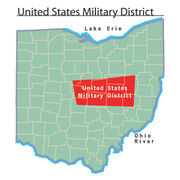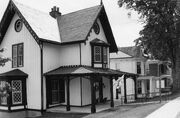The Virginia Military District in the Middle West

What is the Virginia Military District?
The Virginia Military District is a significant piece of land that has much history in Ohio. The land was once owned by Virginia and was used as payment for Virginia's Revolutionary war veterans. This land supported and housed many veterans based on a criteria when the war ended. It also may have been influencial on the ideal use of land according to the Jeffersonian Democracy.
Where is the land located?
The land is located in what is now known as Ohio, but was owned by Virginia. This territory was bordered the Ohio River on the south, the Little Miami River to the west, and the Scioto River on the east and south. The Virginia Militay Distirct was an approximatly 4.2 million acre of land in what is now Ohio (Virginia).

What's the history behind the district?
In the late eighteenth and early nineteenth centuries, the Virginia Military District was an early land division in what would eventually become Ohio. After the American Revolution, Virginia gave up most of its claims to western lands before the passage of the Northwest Ordinance of 1787. The Northwest Ordinance is basically for the division and settlment of the United States. However, the state kept an area of land in the Northwest Territory called the Virginia Military District The state used these lands as payment to Virginia's Revolutionary War veterans. The first settlement in the Virginia Military District was Massie's Station, which was founded in 1790. The village of Chillicothe was founded quite early as well. Many Virginians settled in the area. In some cases, newcomers gave up their slaves in order to move to Ohio since the Northwest Ordinance did not allow slavery in the territory ( Ohio).
Claiming land of the Virginia Military District required that you be a part of the war. Whether or not a soldier received land was dependent on time and length of service as well as the rank of the soldier compared to other soldiers. The first step was to secure a proper certificate of actual service and to then acquire a printed warrant from the land office in Virginia specifying the quantity of land. This warrant gave the person power to select the specified area from anywhere within the military reserve district. After the location was chosen and boundaries surveyed, the owner of the warrant exchanged it for a patent, which was equivalent to a deed in fee simple and passed all title of the government to the holder. The land was never divided into regular townships, as in the Public Lands Survey System, and because persons could select their allotment from anywhere within the district, there were frequently competing and overlapping claims (Wiki). Virginia eventually gave back to the United States government any lands that had not been claimed by veterans. The federal government then gave the land to the State of Ohio. In 1872, the Ohio legislature used the income from this land to create an endowment for The Ohio State University and was then more or less divided into townships (Virginia).
Who settled in the district?
The district was open for settlement in 1794 and mostly caucasian Virginians settles in the area. Slavery was not allowed in the district so many white americans from all different areas decied to settle here without their slaves at hand.

What is the land currently used for?
Not much has changed in the military disitrict. The lands are more of a township layout with many people taking care of individual farms etc. Some of the land was sold off and the Ohio State University was built there. Not a whole lot of information on its current uses because the history was so significant for Ohio that made it what it is today.
References:
1) Virginia Military District. http://en.wikipedia.org/wiki/Virginia_Military_District. May 22, 2010.
2) Virginia Military District. Ohio History Central. http://www.ohiohistorycentral.org/entry.php?rec=817. May 22, 2010